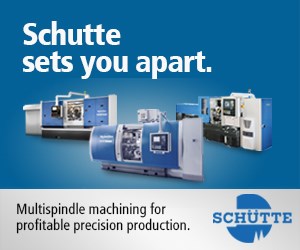ADDITIVE MANUFACTURING

Metal and polymer additive manufacturing/3D printing is increasingly being used to make new design prototypes and production parts as well as jigs, fixtures and other devices used in a machine shop.
Narrow by Additive Manufacturing Product Category
FAQ: Additive Manufacturing
What materials are used in additive manufacturing?
There are two main types of materials used in additive manufacturing: polymer and metal. Each has different strengths, weaknesses and uses, especially when it comes to how they are used in combination with turning processes:
Polymer. Polymer (or plastic) AM can produce parts that cannot be made by traditional machining processes, such as complex internal features in medical implants. It can also produce one-off parts quickly. In addition, these systems tend to be easy to program and can be run without much training or special expertise. However, accuracy and surface finish can be a challenge, and the technology is only cost-effective for producing small volumes of parts.
Metal. Metal 3D printing can also produce parts with features that cannot be machined. Like polymer 3D printers, metal 3D printers struggle with accuracy and surface finish. In addition, they are expensive (capital equipment and infrastructure costs are currently between $300,000 and $1.2 million, according to Mr. Miller) and often require special expertise (such as metallurgy), which makes them difficult to implement. Shops also need to consider the material properties of 3D-printed metal parts. Metal 3D-printed parts may be able to replace castings, but the technology cannot replicate the material properties of forgings.
Metal additive manufacturing can also be combined with traditional, subtractive machining methods. Hybrid manufacturing systems are CNC machines (usually multitasking or milling machines) with metal deposition heads. This design gives them the ability to both add and remove stock within the same machine.
How can production shops use AM for turning operations?
There are several ways shops that focus primarily on turning could use or encounter additive manufacturing:
Tooling and fixturing. For polymer 3D printing, Mr. Miller says the number one use in the machining space is tooling. Although turning does not require the complicated tooling and fixturing of milling, additive manufacturing can still prove useful. For example, a shop could 3D print a plastic sleeve to protect delicate parts from being damaged by the chuck as they are being turned. The sleeve fits around the part, and both go into the chuck.
Designs and prototypes. Polymer AM is also well-suited for design and prototyping. For shops that do a lot of up-front prototyping, buying a 3D printer and doing the work in house could be more cost-effective than outsourcing the work. Polymer 3D printing offers a quick turnaround on prototypes, which can be used to determine form, fit and possibly function. “You can make sure the parts are good before you go to machining and make 300 or 3,000 of them,” Mr. Miller says. He adds that 3D printing can help speed the design process for design engineers. “Advanced rendering capabilities allow us to visualize work on a computer screen quite well these days, but there’s nothing like holding it in your hand and putting the parts together to see if they fit,” he says.
Replacing metal castings and weldments. Metal AM can be used instead of a number of different processes for producing parts. For example, injector nozzles that in the past were made of several parts welded together can now be 3D printed as one part. Castings are also being replaced with metal additively manufactured parts. When these parts come out of the 3D printer, they require additional work. “We can’t 3D print really highly accurate surfaces,” Mr. Miller says. “We still have to machine those critical surfaces.” Understanding additive manufacturing technology, as well as its strengths and weaknesses will help shops perform these machining operations. Mr. Miller sees this as a key area of growth and a big opportunity for shops. For shops that do perform these operations, he adds that it is helpful for them to consider 3D printing as part of their upstream process.
Producing parts that can’t be machined. Possibly the biggest advantage of additive manufacturing is that it can be used to produce parts that cannot be machined. Aerospace parts and medical implants with complex internal features, for example, can be 3D printed in either metal or plastic. These parts must then be brought into tolerance using machining methods such as turning.
Repairing parts. According to Mr. Miller, hybrid manufacturing systems are mostly used for repair. The additive manufacturing capabilities of these systems are used to add stock to damaged parts, which can then be turned in the same machine to be brought into tolerance.
Get Listed!
Thousands of people visit this Supplier Guide every day to source equipment and materials. Get in front of them with a free company profile.




.jpg;maxWidth=300;quality=90)



